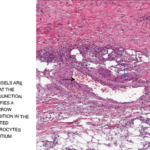These syndromes were completely ignored in U.S. literature for years
Search results for: giant cell arteritis
Two Inflammatory Conditions—Polymyalgia Rheumatica and Giant Cell Arteritis—Share Clinical Connection
Polymyalgia rheumatica (PMR) and giant cell arteritis (GCA) have common clinical and epidemiologic links, but they need not occur synchronously
Giant Cell Arteritis
Giant cell arteritis (GCA)—a type of vasculitis—is a group of diseases whose typical feature is inflammation of blood vessels. The blood vessels most commonly involved are the arteries of the scalp and head (especially the arteries over the temples), which is why another term for GCA is “temporal arteritis.” GCA can overlap with another rheumatic disease called polymyalgia rheumatica, and symptoms of the two conditions can occur at the same time or separately. The causes of GCA and polymyalgia rheumatica are unknown.
Higher Fracture Risk in Patients with Polymyalgia Rheumatica, Giant-Cell Arteritis
NEW YORK (Reuters Health)—Patients with polymyalgia rheumatica (PMR) and giant-cell arteritis (GCA) have similarly increased risks of fracture, compared with the general population, researchers have found. “It is of surprise that patients with GCA have a similar fracture risk to those with PMR,” Dr. Zoe Paskins from Keele University, in Staffordshire, told Reuters Health by…

Case Report: A Polyarteritis Nodosa Conundrum
Polyarteritis nodosa (PAN) is a systemic necrotizing vasculitis that typically affects medium-sized muscular arteries. The clinical subsets of PAN are idiopathic, generalized, secondary hepatitis B virus (HBV) associated and cutaneous PAN. These clinical subsets are important because of their therapeutic implications. Virtually any organ system can be affected in generalized PAN, but this vasculitis tends…

Vasculitis Guidelines in Focus, Part 5: Takayasu Arteritis
Andy Abril, MD, a lead author of the ACR/VF guideline for Takayasu arteritis (TAK), discusses the recommendations for TAK.

Vasculitis Guidelines in Focus, Part 4: Polyarteritis Nodosa
Jason Springer, MD, MS, served as one of the lead authors of the ACR/VF guidelines for polyarteritis nodosa (PAN), and talks about the recommendations specific to PAN here.

Update on the Management of Takayasu Arteritis
A rare form of large vessel vasculitis, Takayasu arteritis persents with no clear patterns, with patients experiencing vascular symptoms, as well as such systemic symptoms as fever and weight loss. A systematic literature review found evidence to guide rheumatologists in monitoring and treating their patients with Takayasu arteritis…

Kussmaul, Meier & Polyarteritis Nodosa
In 1866, Adolf Kussmaul, an internist, and Rudolf Maier, a pathologist, published the classic characterization of what eventually became known as polyarteritis nodosa.1 It was the first scientific clinical characterization of a noninfectious vasculitis. As such, it became a paradigmatic point of contrast to other types of vasculitides that were later described. Their description also…

The Link Between Takayasu’s Arteritis & Increased Stroke Risk
Approximately 16% of patients diagnosed with Takayasu’s arteritis (TA) experience a stroke. In a recent study, researchers found patients with TA and stroke had higher levels of C-reactive protein at diagnosis…
- « Previous Page
- 1
- 2
- 3
- 4
- 5
- …
- 18
- Next Page »